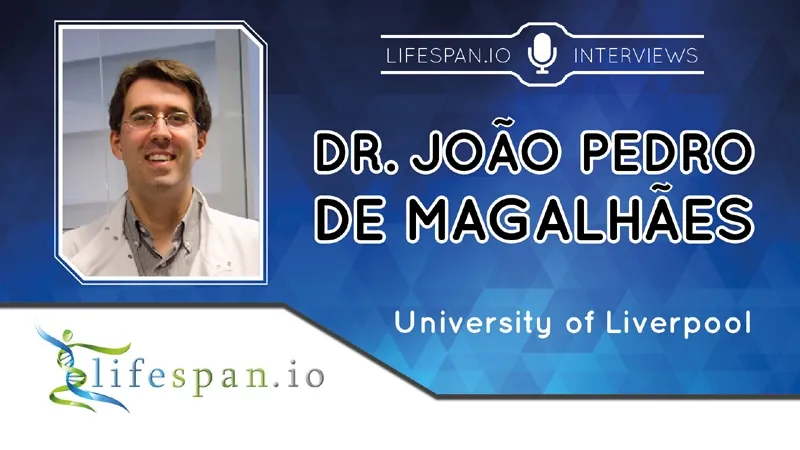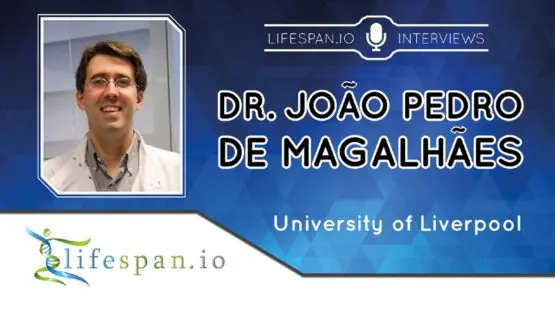Today, we have an interview with Dr. João Pedro de Magalhães, the biogerontologist who created and runs senescence.info.
How do you think we age; are we programmed to die, do we wear out, or is the truth a mixture of both?
I don’t think we wear out. Humans and complex animals are made of cells and molecules that, by and large, have some turnover; we can replace most of our components, so I don’t think it’s correct to see aging as wearing out, at least not in complex animals like humans. (Please see here.) That said, I do think that some forms of cumulative damage contribute to the aging process, such as DNA damage. I also think that there are programmatic aspects to aging. That is, I think that genetic programs coordinating some aspects of growth and development persist into adulthood and become detrimental as forms of antagonistic pleiotropy. It is probably a combination of molecular damage and the inadvertent actions of genetic programs that causes aging.
There seems to be an increasing suggestion in academia that directly targeting the underlying aging processes, as opposed to individual age-related diseases or symptoms, is the most promising strategy if we wish to knock out multiple diseases at once. Are you enthusiastic about the approach, and why do you think there has been a surge of support for this strategy?
Absolutely; this is something that biogerontologists have been arguing for a very long time. I also think that the graying of the population means that there is a growing awareness of the need to develop approaches to tackle the process of aging and associated pathologies.
There also seems to be an increasing amount of investment in rejuvenation biotechnology in the last year, with big names like Jim Mellon, Jeff Bezos, and others investing funds into biotech aimed at aging. Why do you think we are seeing this big increase in investment; what has happened in science to encourage this commitment?
There’s more than one reason to explain this recent excitement in anti-aging biotech. One reason is the aforementioned graying of the population, making anti-aging interventions commercially very appealing. In addition, the discoveries of the past couple of decades showing that the process of aging is plastic and can be manipulated in model organisms has generated tremendous excitement. Even in mice, we can tweak one gene and extend lifespan by nearly 50%, retarding a multitude of age-related pathologies. If we could do that in humans, that would mean making people not only live longer but stay healthy for longer. Again, from a financial perspective, that would have huge implications, and any company that were to develop a true anti-aging intervention would make huge profits. My recent review of the business of anti-aging science discusses this topic in more detail.
You said that “humans are not huge worms or big mice” in this review. While different species have developed a variety of different longevity pathways, and those pathways do not always work in the same way, there are some conserved pathways common to mice and humans that may prove useful. Are you optimistic that we might find and use some of these, or should we be moving away from mouse models and finding something better?
Indeed, we know of conserved longevity pathways across model organisms, and some of these may also be relevant to humans. The million-dollar question is knowing which pathway or target is relevant in humans or in which humans. My intuition is that most of what we discover about longevity manipulations in model systems will not be relevant to most people. However, some longevity genes and pathways from model systems may be important for at least some people. The challenge is to discover and be able to predict (using genetic and phenotypic information) who will benefit from which longevity manipulations. Overall, I am optimistic that we will discover some uses of longevity genes and pathways, even if the effects in humans will not be as impressive as in animal models. As for whether we should be moving away from mice, not necessarily. We still need mouse models. That said, I think we need to employ a greater diversity of models, and that includes a greater diversity of mouse models and also other animal models, for example, dogs and primates, which some labs are using already.
If we are to move away from mice and other species, how do you feel about the prospects for creating better human analogues via either in silico modelling or organs on chips?
For a complex process like aging, I think that is still too early. We still lack the comprehensive understanding of biology to develop accurate predictive models. Although I am very fond of computational models, and clearly they are playing a growing role in not just research on aging but other fields as well, they are still far from perfect and still require experimental validation, ultimately in clinical trials.
There has been considerable interest in the NAD+ salvaging pathway in recent years, and, indeed, NAD+ plays a critical role in cellular functions and crosstalk with sirtuins to mediate blood vessel development and maintenance. Is NAD+ repletion via small molecules or other methods something that you have been following, and are you optimistic about the potential of this approach?
NAD+ is one of several promising longevity pathways in animal models. It’s been reported to have health benefits, but it only slightly extends lifespan in mice, so it’s not something I’ve been holding my breath about.
Senescent cell clearance has been a hot topic for the last couple of years, and with human trials poised to launch, it seems that we may have a potential anti-aging therapy. If the trials are successful, do you think it could be the catalyst to ignite wide public support for research focused on targeting the aging processes?
Any trial that is successful in demonstrating a retardation of aging or, ideally, rejuvenation of multiple aspects of aging would be a major breakthrough. Whether clearance of senescent cells will do this remains a big question. Most of the data we have so far on the role of cell senescence in aging comes from model systems and mice in particular, so it’s important to emphasize that we don’t really know if senescent cells play a significant role in human aging.
What are the components of your personal strategy to remain healthy for as long as possible?
I try to take some care of my health (like I think everyone should) by practicing regular exercise, not smoking, avoiding alcohol, and having a moderately balanced diet. My diet is not extremely healthy, however; I’m too fond of ice cream, particularly now in the summer. That said, life is about finding a balance between trying to stay healthy but also enjoying the pleasures of being alive. I am not like that married couple who didn’t drink alcohol, didn’t smoke, didn’t eat meat, and even their children were adopted!
What is the biggest bottleneck to progress in aging research, in your view?
Most scientists would say lack of funding, but while having more funding would certainly accelerate progress, I think it would only help so much. This is because experiments in aging, and potential human clinical trials, are intrinsically time-consuming. That is not going to change with more funding. I would argue that the biggest bottleneck to progress in aging is the nature of the aging process itself in that it takes quite a long time, which, in turn, means that studies and trials will also take a long time.
Thanks to Dr. de Magalhães for once again dedicating some of his precious time to share his views with us!




